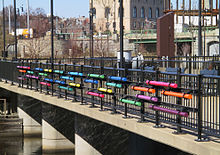Paul Matisse
Paul Matisse (* 1933 in New York ) is an American artist and inventor. He is particularly known for his installations , some of which are interactive . He is the inventor of the calliroscope .
life and work
Paul Matisse is the son of Pierre Matisse and Alexina "Teeny" Matisse , née Sattler, who was second married to Marcel Duchamp , and the grandson of the French painter Henri Matisse . In 1954, Paul Matisse graduated from Harvard University, where he lived in Eliot House with Stephen Joyce , the grandson of James Joyce, and Sadruddin Aga Khan . After college, he briefly studied at the Harvard Graduate School of Design before joining Arthur D. Little in product development .
On December 27, 1958, Matisse married Sarah Barret. The wedding Duchamp gave his stepson as an art object Waistcoat , a vest made of green wool, on the five buttons in mirror writing Sally could read her pet name. In 1962 Matisse went into business for himself and made calliroscopes . In 1965 his daughter Sophie was born. In 1968, after Duchamp's death, he arranged his extensive estate and translated and published a large number of notes into English. On behalf of the Philadelphia Museum, he reconstructed a posthumously discovered and at the time quite shocking Duchamp masterpiece, Etant Donné . Like his stepfather, who set the traditional art scene in motion with ready-mades , Paul Matisse is also fascinated by kinetic art.
From 1977 to 1979 Matisse helped Alexander Calder create a sculpture for the National Gallery of Art in Washington . After that his artistic career began.
He currently resides in a former Baptist church in Groton, Massachusetts .
Works (selection)
- Memorial Bell for the "National Japanese-American Memorial to Patriotism" in Washington (2001)
- Charlestown Bells (2000), an interactive musical sculpture on the Charles River Dam between Boston and the Charlestown neighborhood
- Kendall Band (1987), an interactive musical sculpture in a subway station in Cambridge , Massachusetts
- Musical Fence (1980), an interactive musical sculpture formerly displayed in Cambridge Massachusetts and now displayed at the DeCordova Museum in Lincoln, Massachusetts and the Science Museum in Vermont .
literature
- Paul Matisse: Notes Duchamp . New edition, Flammarion, Paris 2008, ISBN 978-2-081-21741-6
Web links
- kalliroscope.com
- Portrait of Paul Matisse by Henri Matisse, 1946
- Artcyclopedia website
- Musical Fence at the DeCordova Museum
Individual evidence
- ↑ Christopher Reed, Pure Fabrications , Harvard Magazine , May – June 2002.
- ↑ Cora von Pape: art clothes. transcript-verlag, accessed April 15, 2009 .
- ↑ Hella Boschmann: A Matisse who makes the bells ring. welt.de, August 20, 2002, accessed April 15, 2009 .
| personal data | |
|---|---|
| SURNAME | Matisse, Paul |
| BRIEF DESCRIPTION | American artist |
| DATE OF BIRTH | 1933 |
| PLACE OF BIRTH | new York |
